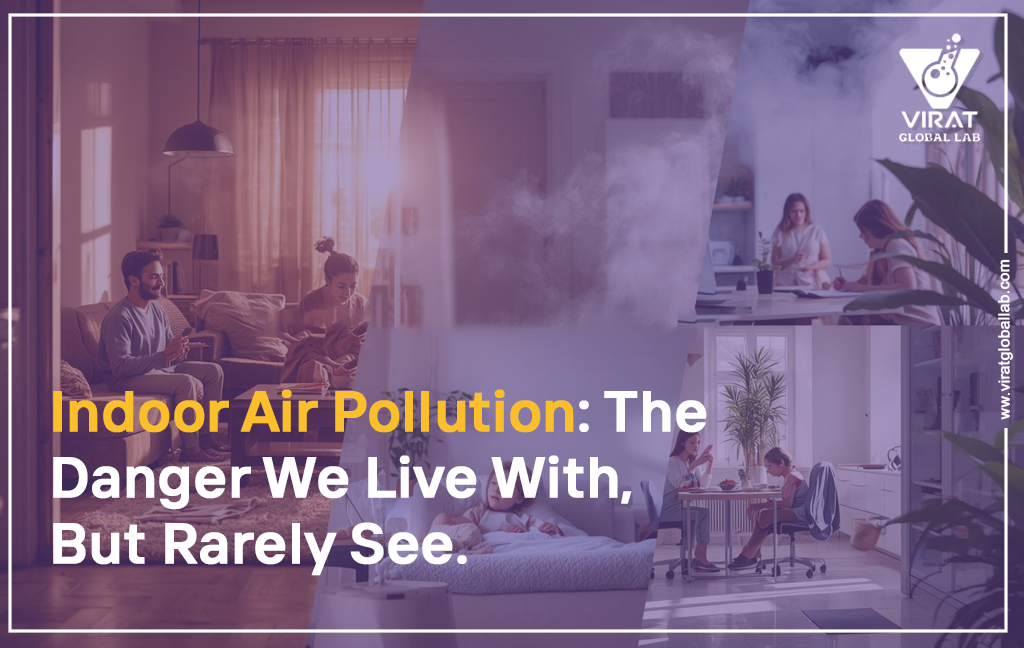
When we think about pollution, images of smog-filled skies, traffic fumes, and industrial chimneys often come to mind. But what many of us overlook is that the air inside our homes, offices, and schools can sometimes be more polluted than the air outside. Indoor Air Pollution is a silent but serious problem that directly impacts our health and well-being.
What is Indoor Air Pollution?
Indoor air pollution refers to the contamination of the air inside buildings from harmful particles, gases, and biological agents. Unlike outdoor pollution, which is often visible, indoor pollutants are invisible, odourless, and can accumulate in confined spaces — making them even more dangerous.
Common Sources of Indoor Air Pollution
Indoor air pollution arises from multiple everyday sources that often go unnoticed. One of the most common contributors is
5.Tobacco smoke remains one of the most hazardous indoor pollutants, as second-hand smoke contains more than 7,000 chemicals, many of which are toxic and carcinogenic.
Case Study: Indoor Air Quality in Delhi’s Buildings
A striking example of the seriousness of indoor air pollution comes from a survey conducted by the Centre of Excellence for Research on Clean Air (CERCA), IIT Delhi, the Society for Indoor Environment (SIE), and air quality company Kaiterra. Released on 20th February 2021, the study — known as Project MAQUID (Monitoring of Air Quality in Urban Indoors in Delhi) — examined 37 buildings across Delhi, including schools, colleges, hospitals, offices, restaurants, shopping malls, and cinemas.
The results were alarming:
The study also highlighted contributing factors such as airtight buildings with inadequate ventilation, use of VOC-rich paints and cleaning agents, high occupancy, poorly maintained equipment (photocopiers, printers), and lifestyle habits.
This survey underlines that indoor air quality is not just a rural biomass issue, but a serious urban health risk that requires urgent attention in cities like Delhi.
Health Impacts of Indoor Air Pollution
The World Health Organization (WHO) estimates in 2024 that 3.2 million people die every year from illnesses linked to household air pollution. The risks are particularly high for children, elderly, and people with pre-existing conditions.
The Delhi study findings confirm these risks, showing that high levels of particulate matter, VOCs, and CO2 in everyday spaces like schools, hospitals, and offices could have long-term health impacts on millions of urban residents.
How to Reduce Indoor Air Pollution
The Way Forward
Indoor air pollution is not just a household issue — it is a public health challenge. Governments, organizations, and individuals need to work together to raise awareness, promote cleaner cooking fuels, and set stricter standards for indoor air quality.
The Delhi case study shows that even in modern, urban environments, poorly managed indoor spaces can trap and amplify pollutants. This calls for stronger indoor air quality standards, better building designs, and public awareness campaigns.
After all, we spend nearly 90% of our time indoors. The air inside our homes should nurture us, not harm us. By taking conscious steps, we can make our indoor spaces healthier and safer for everyone.
At Virat Global Lab, (a division of Aseries Environtek India Private limited) we believe that clean indoor air is not a luxury — it is a necessity for a healthy life. Indoor air pollution silently affects our homes, workplaces, schools, and hospitals, putting millions at risk of respiratory and cardiovascular diseases every year.
We are committed to raising awareness, conducting advanced indoor air quality testing, and providing reliable data that helps individuals, institutions, and policymakers take informed steps toward safer environments.
Whether it’s your home, office, hospital, or educational institution, regular indoor air testing is the first step in protecting your loved ones, employees, and communities.
As the most trusted air testing lab in India, we proudly provide services across the country
At Virat Global Lab (A Division of Aseries Envirotek India Pvt. Ltd.), we invite businesses, Industries and institutions across various sectors to explore the benefits of partnering with us for their environmental testing and analytical needs.































